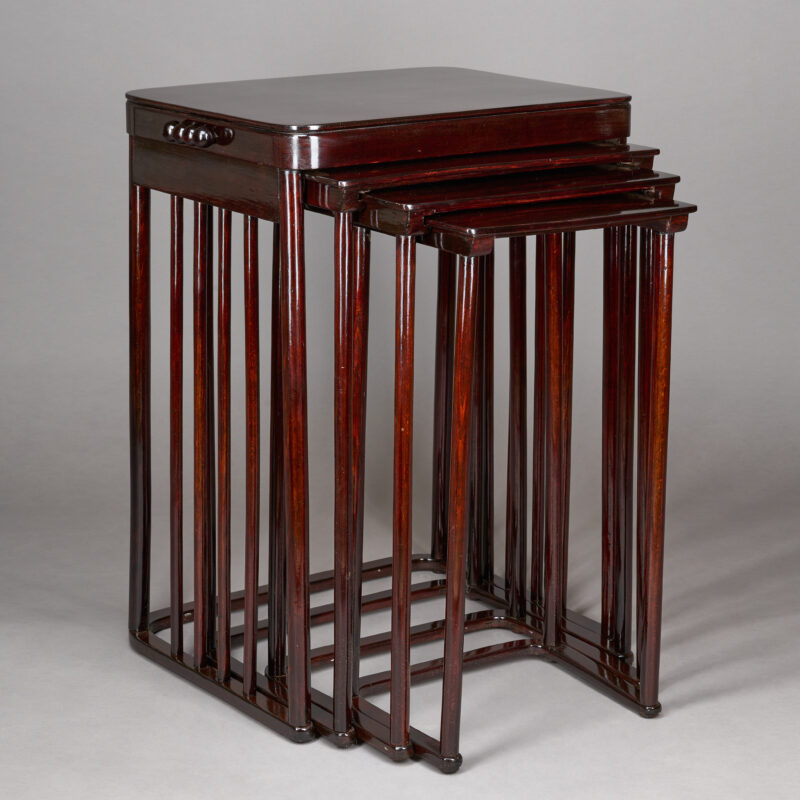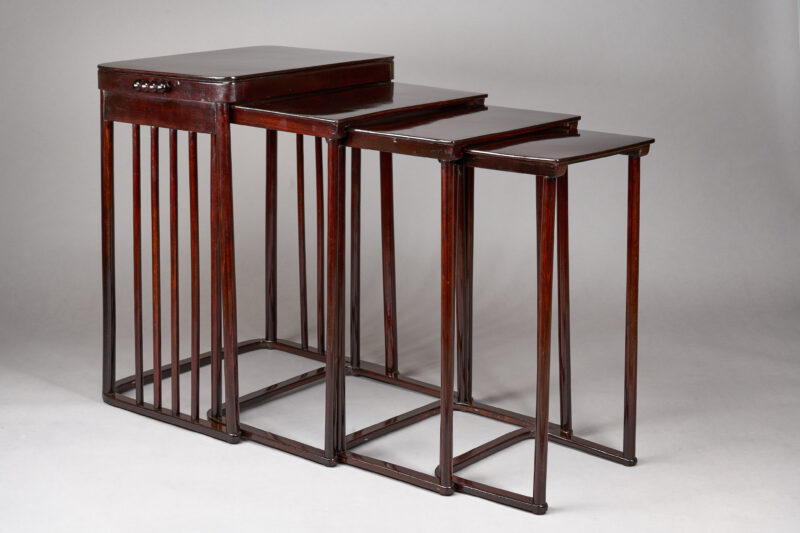
Four nesting tables by Josef Hoffmann
Designed by Josef Hoffmann, executed by J. & J. Kohn from 1906, model no. 986. Paper labels with the signature of J. & J. Kohn on the smallest table.
Made of beech wood and plywood, stained mahogany, and polished with shellac. Personal note: This model of the nesting tables designed by Hoffmann is a design classic and is certainly one of the most beautiful of this era.
Literature: Sales catalog J. & J. Kohn, 1906, p. 52; Sales catalog J. & J. Kohn, 1916, p. 79;G. Renzi, Il mobile moderno, Gebrüder Thonet Vienna, Jacob & Josef Kohn, Milan 2008, p. 180 f; Illustration: Das Interieur, Vol. 9, 1908, p. 28.
Josef Hoffmann (1870−1956):
Josef Hoffmann was born in 1870 in Pirnitz/Moravia during a socially and politically difficult time, but it was also the beginning of the Industrial Revolution with all its positive and negative aspects. In 1892, Josef Hoffmann began his architecture studies at the Academy of Fine Arts in Vienna under Carl von Hasenauer and Otto Wagner. He was early on fascinated by the English-Scottish Arts and Crafts movement, whose vision was to fill all areas of life with art, design everyday and utilitarian objects in a more beautiful and aesthetic way, and make artfully designed objects accessible to a broader social class. J. Hoffmann, as well as his teacher Otto Wagner, believed that art could even have a healing effect on the human soul. They believed that the role of the architect should be much larger, that the architect should also be a designer, and that all objects to be used should be redesigned. Hoffmann remained true to this credo throughout his life. At the young age of just 29, Hoffmann was already appointed professor at the University of Applied Arts in Vienna. This was followed by one of the significant steps in Hoffmann’s career, after he joined the “Vienna Secession” in 1897 with Gustav Klimt, Koloman Moser, Joseph Maria Olbrich, Carl Moll, and others. This association saw itself as a counter-movement to the established artists. Only six years later, he founded the Wiener Werkstätte together with Koloman Moser and with the support of industrialist Fritz Waerndorfer in 1903. The Sanatorium Purkersdorf, implemented in 1904, must be counted among the first eight iconic masterpieces of Hoffmann, in which he designed everything down to the smallest detail, from the interior to the gardens. This overall work of art set almost radical new standards in the view of architecture and design. One of Josef Hoffmann’s most significant works, which ultimately brought him international breakthrough, was the Stoclet Palace in Brussels. In this building, which he realized between 1905 and 1911, he was able to fully realize his vision of a total work of art. Architecture and design merge with daily life, and art becomes an aesthetic part of our everyday life. An interesting aspect of the idea of a total work of art would be that the important Danish-Austrian master builder and architect of Classicism and Historicism, Theophil Edvard Hansen (1813 in Copenhagen — 1891 in Vienna), had the vision of a total work of art of building and furnishing and was also able to implement it in some of his projects in Vienna. The strict and clear design language of Hoffmann’s designs paved the way for modernism and, like Adolf Loos’s designs, are works of timeless elegance, made with the highest possible quality and execution. An important quote from Le Corbusier about Josef Hoffmann might be: “Today, when the new generations…take ownership of the fruits of the work of the true pioneers, it is only fair…to express our gratitude to men like Professor Hoffmann and to companies as bold as the Wiener Werkstätte. Finally, what remains is the indispensable superfluous, art.”

